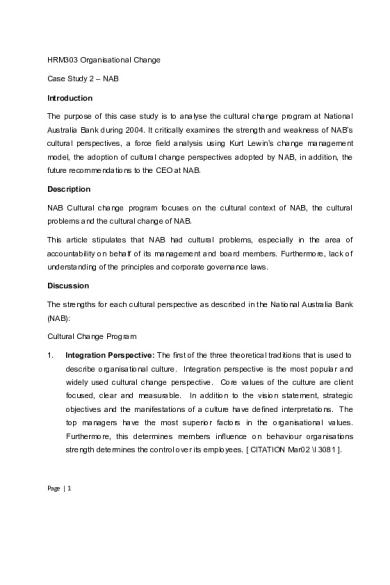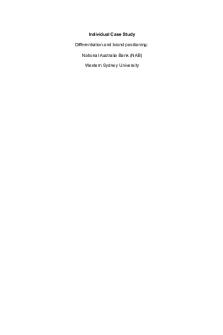Case Study 2 - NAB - Grade: 8.5 PDF

| Title | Case Study 2 - NAB - Grade: 8.5 |
|---|---|
| Author | Phillip Mules |
| Course | Organisational Change |
| Institution | Griffith University |
| Pages | 6 |
| File Size | 91.8 KB |
| File Type | |
| Total Downloads | 21 |
| Total Views | 148 |
Summary
Case Study 2 - NAB - Grade: 8.5...
Description
HRM303 Organisational Change Case Study 2 – NAB Introduction The purpose of this case study is to analyse the cultural change program at National Australia Bank during 2004. It critically examines the strength and weakness of NAB’s cultural perspectives, a force field analysis using Kurt Lewin’s change management model, the adoption of cultural change perspectives adopted by NAB, in addition, the future recommendations to the CEO at NAB. Description NAB Cultural change program focuses on the cultural context of NAB, the cultural problems and the cultural change of NAB. This article stipulates that NAB had cultural problems, especially in the area of accountability on behalf of its management and board members. Furthermore, lack of understanding of the principles and corporate governance laws. Discussion The strengths for each cultural perspective as described in the National Australia Bank (NAB): Cultural Change Program 1.
Integration Perspective: The first of the three theoretical traditions that is used to describe organisational culture. Integration perspective is the most popular and widely used cultural change perspective. Core values of the culture are client focused, clear and measurable.
In addition to the vision statement, strategic
objectives and the manifestations of a culture have defined interpretations. The top managers have the most superior factors in the organisational values. Furthermore, this determines members influence on behaviour organisations strength determines the control over its employees. [ CITATION Mar02 \l 3081 ].
Page | 1
2.
Differentiation Perspective:
Focusing on the inconsistencies of the cultural
manifestations among the organisation's members. The different sections of an organisation have separate related cultures. A series of subcultural, independently or in a conflict with each other, clear and, identifiable recognising cultural diversely which has a potential for conflict between the subcultures. [ CITATION Mar02 \l 3081 ]. 3.
Ambiguity Perspective: Lack of clarity in the fragmentation process perspective and the cultural manifestation, are clearly consistent and inconsistent but are related to each other. [ CITATION Mar02 \l 3081 ].
Furthermore, the many
subcultures within the fragmented cultures have no set of shared opinions, analysing the relations between the subcultures is an effective part of the differentiation perspective, with the inconsistent cultural manifestations of any particular subculture, are applicable and effective. Weakness for each cultural perspective within NAB 1.
Integration Perspective: Throughout the organisations, the unfavourable traits are transferred through the organisation. In addition, the cultures that we not being detected can prove harmful to.[ CITATION Mar92 \l 3081 ].
2.
Differentiation Perspective: Internally and externally inconsistencies are the identified cultures that are depicted as being groups of manifestations that contradict each other.
3.
Ambiguity Perspective: Employees are indifferent and they may agree or disagree on the management procedures of the organisation. Employees being dissatisfied with the whole management process [ CITATION Alv95 \l 3081 ].
Page | 2
The Kurt Lewin’s Change Management Model Force Field Analysis [CITATION Kur \l 3081 ] The force field analysis model was created by Kurt Lewin which makes various decisions of behaviour by analysing forces in opposite directions [CITATION Kur \l 3081 ] Step 1: Unfreezing: Reducing the forces, but maintaining the organisations present level of behaviour. Unfreeze the organisation from its current state. Step 2: Moving: Move from less acceptable behaviour to a better set of behaviours, values and attitudes. Improving the desired change. Step 3: Refreezing: Stabilising the forces of the new equilibrium.
In addition, to
reinforce states of cultures, rewards and structures. Another good way to minimise resistance can be done by: 1.
Motivation
2.
Involvement
3.
Commitment
The Australian Prudential Regulatory Authority (APRA) identified numerous limitations within the NAB framework including the cultural issues which were the main factors of NAB (Australian Prudential Regulatory Authorities [ CITATION The04 \l 3081 ]. As stated by [ CITATION Mar02 \l 3081 ], the functionalist – integrative perspective is much more effective in analysing the culture in an organisation. The steps NAB took for its cultural change: 1.
NAB as a client-focussed organisation readjusted the main priorities.
2.
Invested in its people, reputation and cultures.
3.
To benefit the customers, employees and the community NAB started to differentiate its reputation and cultures.
Page | 3
4.
The manifestations of NAB’s culture through visions, objectives and mission statements.
Reflecting the NAB portfolio. 5.
The re-launch of NAB brand logo.
6.
Developing team-oriented structures
7.
Focusing on community developments
The future recommendations to the CEO or the HR Team at NAB would be: 1.
New leaders to make substantial efforts to carry out cultural changes in an effective structure.
2.
Management to fix the lack of accountabilities and responsibilities by effective implementation of change
3.
CEO John Stewart needs to think like a chief ethics officer rather than a CEO, conveying strong strict messages helping his fellow leaders in organisation commitment.
4.
The organisation needs to be client focused, not as profit focused, creating shortterm references favourable for unethical behaviour [ CITATION Coo91 \l 3081 ].
5.
NAB needs to develop a proper reaction to crisis strategies.
6.
NAB needs to develop strategic steps for managing underlying issues instead of managing the messages inside NAB.[ CITATION The04 \l 3081 ].
Conclusion Page | 4
In conclusion, NAB’s losses provided evidence that neglecting risk management and the regulator need to take steps to monitor the organisations capital requirement leadership focussed on profit processes and a dismissive management style. Cultural change needs personal commitment. Leaders will need to be knowledgeable and to understand their responsibilities. Allocate funds and corporate powers monitoring management with very little of the government interference. In addition to providing a framework that improves the areas of corporate governance and regulations.
Recommendations 1.
The six primary implements used by the leaders for reinforcing the organisation need to be changed.
2.
New goals should be introduced to the managers and individuals in line with the management.
3.
The new commitments of the employees will take the organisation to better and higher levels.
4.
NAB has a good news culture which ensures bad news promptly instead of letting the problems grow bigger.
Bibliography Alvesson, M. (1995). Cultural Perspectives on Organizations. Page | 5
Cooke, R. A. (1991). Danger signs of unethical behaviour: How to determine if your firm is at ethical risk. Journal of Business Ethics, 249–253. doi:doi:10.1007/BF00382962 Lewin, K. (1946). Force Field Analysis. The 1973 Annual Handbook for Group Facilitators, 111-13. San Diego: University Associates, Inc. Martin, J. (1992). Cultures in Organizations: Three Perspectives. Oxford University Press. Martin, J. (2002). Organizational Culture Mapping The Terrain. SAGE Publications, Inc. The Australian Prudential Regulation Authority. (2004). Retrieved from APRA.
Page | 6...
Similar Free PDFs

Case Study 2 - NAB - Grade: 8.5
- 6 Pages

NAB Essay - NAB case study
- 7 Pages

NAB article 1 Case Study
- 4 Pages

Pbl case study 2 -2 - Grade: A
- 7 Pages

Lab Report - Grade: 85
- 5 Pages

Defamation essay - Grade: 85
- 17 Pages

Essay 1correction - Grade: 85
- 5 Pages

Sample memorandum - Grade: 85
- 8 Pages

Hugo Essay - Grade: 85%
- 4 Pages

Miss Representation - Grade: 85
- 5 Pages

Final Case Study #2 - Grade: A
- 5 Pages

Case study 2 final - Grade: a
- 8 Pages

Case Study 2 AEO - Grade: A+
- 3 Pages

85% Grade Business Plan Example
- 49 Pages
Popular Institutions
- Tinajero National High School - Annex
- Politeknik Caltex Riau
- Yokohama City University
- SGT University
- University of Al-Qadisiyah
- Divine Word College of Vigan
- Techniek College Rotterdam
- Universidade de Santiago
- Universiti Teknologi MARA Cawangan Johor Kampus Pasir Gudang
- Poltekkes Kemenkes Yogyakarta
- Baguio City National High School
- Colegio san marcos
- preparatoria uno
- Centro de Bachillerato Tecnológico Industrial y de Servicios No. 107
- Dalian Maritime University
- Quang Trung Secondary School
- Colegio Tecnológico en Informática
- Corporación Regional de Educación Superior
- Grupo CEDVA
- Dar Al Uloom University
- Centro de Estudios Preuniversitarios de la Universidad Nacional de Ingeniería
- 上智大学
- Aakash International School, Nuna Majara
- San Felipe Neri Catholic School
- Kang Chiao International School - New Taipei City
- Misamis Occidental National High School
- Institución Educativa Escuela Normal Juan Ladrilleros
- Kolehiyo ng Pantukan
- Batanes State College
- Instituto Continental
- Sekolah Menengah Kejuruan Kesehatan Kaltara (Tarakan)
- Colegio de La Inmaculada Concepcion - Cebu

